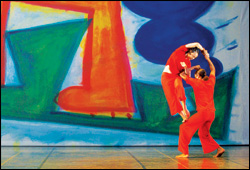WHEN TRISHA BROWN started out as a choreographer, back before the pared-down aesthetic she helped develop got the label “postmodern,” she created a work with just three postures: sitting, standing, and lying on the floor, repeated over and over. As she began to accelerate through the sequence, she got to a point where she was lying down several feet off the ground. “I was flying,” she recalled this past March, speaking at the opening of an exhibit at the Henry Art Gallery about her work with visual artists. She’s been pursuing flight ever since.
Early on, that pursuit was almost literal, as she fit the interiors of art galleries and the exteriors of apartment buildings with rigging so she and her dancers could walk on the walls, with the mechanics laid out for all to see. It was a stunning combination of the pragmatic and fantastical. Dancing on rooftops or on floats in a lake, she made simple gestural phrases look like mysterious languages, like semaphores translated into witchcraft. Her willingness to dance anywhere matched the experimental nature of the times. In a phone interview last week, she talked about a tour in 1967 with visual artist Robert Rauschenberg: “[We were] in Ann Arbor in a parking lot. I made a dance for a skateboard.” After running the board up her body to get the wheels spinning, she executed her movement for as long as their turning could be heard, while Rauschenberg lit her with the headlights from a Volkswagen. (In New York he used a motorcycle.)
Eventually, says Brown, “I got tired of schlepping all that equipment around, up and down stairs,” and she made the choice to start performing in traditional spaces. “It was a major change when I moved to a proscenium stage, rather than performing on rooftops and streets.” Instead of the ambient noise that usually accompanied her work, there was now silence. “People would cough, and it sounded like barking,” she says. Eventually she added the kind of enhanced sound score people expected in a theater, though she says, “My heart just sank—I love the sound of the foot on the floor. You had to light it, and that meant costumes, rather than just long-sleeved white shirts and pants.”
As Brown expanded her collaboration with artists like Rauschenberg, she also developed her movement style, adding a kind of loose-limbed shimmer to what were once randomly structured sequences. Over time, this has become more codified, but still has an unpredictable quality, as if dancers were striding forward while shaking raindrops off their shoulders.
The earliest work her company will perform here is the 1983 Set and Reset, which gave Brown her first international recognition. In the years since, she has continued to collaborate with more visual artists while exploring a wide variety of themes and genres, from jazz to opera. And still, she is pursuing flight. “I used to say I was interested in developing a [movement] vocabulary, but now I say I’m a gesture factory. I was introduced to someone and they said, well you must know a lot of gestures, and I said I knew a billion gestures.”
Trisha Brown Dance Company will perform at 8 p.m. Thurs., May 20–Sat., May 22, $34, at Meany Theater, University of Washington, 206-543-4880. Brown will give a preshow talk at 6 p.m. Sat., May 22.








